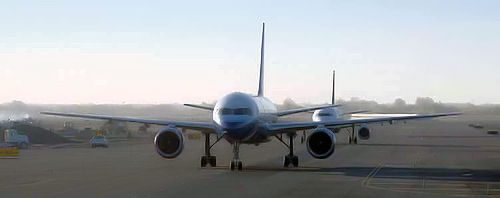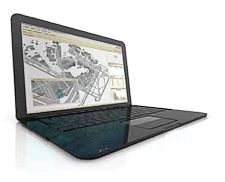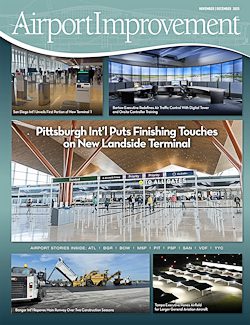 |
 |
Huisman served on the Flight Delay Task Force alongside representatives from the Federal Aviation Administration, Department of Transportation, the Port Authority of New York and New Jersey, airlines operating at Port Authority airports and a number of large New York businesses. Led by then U.S. DOT Secretary Mary Peters, the group convened in 2007 to find ways to trump the various delay scenarios at the three major airports in the New York metropolitan area. It was the first time such major stakeholders came together to develop a strategy to diminish flight delays.
Tool for Collaboration
|
Facts & Figures Project: Ground & Gate Surveillance Location: John F. Kennedy International Airport Stakeholders: Department of Transportation, Federal Aviation Administration, local businesses, Port Authority of New York and New Jersey and its affiliated airlines Technology: Sensis Aerobahn Expanded Coverage Debut: May 2009 |
“(It) would help to allow the Port Authority, the FAA and the carriers to collaborate better and manage the situation on the ground to see where all the aircraft were and to see if aircraft could be moved during various situations to allow for better off times and arrivals at the airport and to and from the gates,” he explains.
The Sensis Aerobahn system not only proved to be a technical fix that could be incorporated at JFK, it was also selected for its ability to mitigate propagated delays across the United States.
According to research conducted by the MITRE Corporation for FAA, an average of 40% of the flight delays in the overall U.S. system originate from delays in the New York area.
In March 2008, conversations between the Sensis Corporation, the Port Authority and its airline users and terminal operators at JFK began to determine how collective goals could be accomplished upon the product’s widespread debut at the airport. The technology was already in use at certain areas of JFK when the Port Authority portion of the contract began in May 2009.
“We had to get the airlines involved in the dialogue because this was going to be paid for by the carriers, through the flight fee system at JFK,” Huisman recalls. “It did not take long to do that because they recognized the value of what this system would provide.”
|
Bill Huisman |
The FAA, explains London, originally selected Sensis as the prime contractor for the Airport Surface Detection Equipment, Model X (ASDE-X) to help prevent runway incursions. The system incorporates multilateration as one of the three surveillance sources used to pinpoint aircraft locations. But unlike traditional radar systems, which only provide the location of the object, multilateration reads an aircraft’s unique identifier based on Mode S transponder signals.
|
Dan London |
Based on the task force’s recommendations, the FAA expedited the deployment of the ASDE-X surface surveillance system at JFK and expanded its multilateration coverage to include gate surveillance. This, notes London, brought the FAA into uncharted territory of non-movement areas.
“Whereas ASDE-X is focused on what goes on out in the taxi area and runways, this expansion took multilateration surveillance into the gate areas – in and around the terminals where the aircraft park and queue up to enter into the movement area,” London explains, noting that JFK is the only airport where gate surveillance has been provided by the FAA and integrated with ASDE-X. “For the first time under this very unique set of circumstances, you have a complete gate-to-airborne surveillance view about what is going on at JFK.”
Multiple Uses
According to London, Aerobahn’s main benefit is the situational awareness of being able to see aircraft on the surface.
“Without multilateration, there isn’t perfect tracking of where an aircraft is,” he relates. “The next step is the benefit of metrics and being able to put some measurements around what is happening on the surface. You can start to extract benefits including the measurement of how many times a taxiway is being used, or the gross total taxi weight that is passed over a taxiway before a taxiway inspection.”
JFK’s airlines, however, are more interested in measuring taxi times.
“The longer the aircraft taxi, the more fuel is required on board,” London explains. “In order for airlines to have an accurate view of how long aircraft are taking to dispatch from the gate and get airborne, they can look at our tool and see how long taxi times are running on the airport and accurately adjust their fuel load to cover that taxi time. The airlines then get the right amount of fuel tailored to what is seen on the surface.”
Implementation of the Passenger Bill of Rights on April 29 will further underscore the benefits of tracking aircraft taxi times. Under the legislation, airlines run the risk of being assessed per-passenger fines for flights with tarmac delays longer than three hours. With Aerobahn, users have an accurate accounting of taxi time and can configure the system to issue a warning alarm if the taxi time exceeds a preset threshold.
Carriers can also use the system as an analytical tool. They can determine how long it takes an aircraft to get from the gate to the taxiway, then out to the runway and finally airborne. They can further compare such data for various sectors within the airport.
According to ADC’s Huisman, all parties are currently pleased with the Aerobahn technology.
“We got on board in May of last year and immediately had people on it for 24 hours straight,” Huisman recalls. “People were just playing with it to enjoy what they were seeing and being able to utilize all of the information it provides.”
Since then, the system has long transcended the novelty stage.




